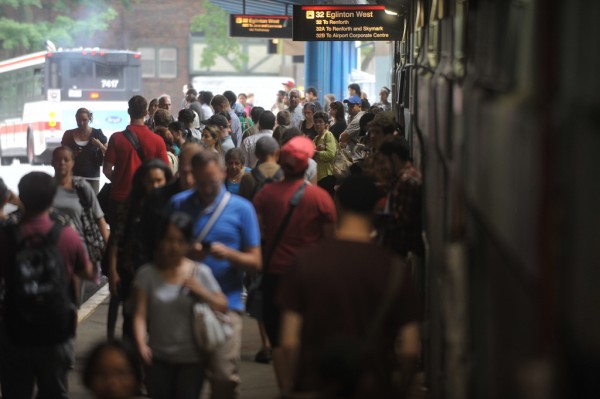Let me say this up front: I have enormous respect for Anne Golden and Paul Bedford. They both understand cities, and have progressive visions of what this particular city could and should become. Yet the fix on their panel’s report was in from the get-go, long before Bedford and Golden set up camp in a cramped suite of offices on the ground floor of the Mowat Block earlier in the fall.
It was always clear, by the panel’s very existence, that Premier Kathleen Wynne and transportation minister Glen Murray didn’t want to have anything to do with the capstone of the Metrolinx revenue tools recommendations — an increase in the HST — and for that reason, the policy analysts working on the Transit Investment Strategy Advisory Panel had their collective hands tied.
Metrolinx, recall, suggested an HST hike, HOV lanes, a parking levy and development charges. The agency’s officials, and its appointed board, knew that developers and the pension funds would hate the latter two suggestions. Yet Metrolinx didn’t come forward with a politically tone-deaf plan. The agency was realistic enough to dismiss contentious options, like highway tolls. Its officials also faced the facts: if we are to build transit, someone’s going to have to pay.
But if politics killed Metrolinx’s politically conscious solution, it seems strange that politics will almost surely kill its politically conscious successor – you know, the one that Murray said the government needs to “own.”
The panel’s analysis is sound, as far as it goes. The gas tax, they concluded, has a better chance to alter behaviour, causing people to drive less. But, as the report notes, a substantial portion of the revenues would be born by freight and transportation companies – “business,” as the report often says. The additional fuel tax won’t alter the behaviour of these firms, but it will almost certainly increase the amount of griping we hear from manufacturers and shippers.
An HST increase — which, as the panel notes, would be not just fair and equitable but decidedly lucrative — is unlikely to impact driver behaviour. True enough, but that was never the political reason for abandoning a form of taxation that has been used in regions like Los Angeles to underwrite transit expansion. Rather, look closely at the language in the report: the fuel tax hits “drivers and businesses” whereas an HST hike impacts “consumers.” Could it be that the policy rationale here is grounded in simple political arithmetic: there are more consumers than drivers, and the Liberals are looking to irritate the minimum number of voters.
Then there’s the notion of borrowing against the new revenue streams, at a ratio of 2.5 to 1, one of the panel’s recommendations. Okay, that’s an option, yet isn’t this idea simply a buy-now/pay-later approach? Indeed, there’s nothing to stop the province from just borrowing to pay for transit. That’s been an option all along.
Finally, there are a handful of apparent policy contradictions between the panel’s findings and the analysis produced last spring by AECOM/KPMG for Metrolinx. Looking at the prospect of a 0.5% corporate tax hike (worth about $190 million/year), that exhaustive 230-page assessment had this to say: “Although corporations benefit from the availability of the regional transportation system, there is no strict user benefit rationale for this tool (i.e. those who pay more income taxes do not necessarily derive greater benefit from the transportation system).” The panel acknowledges that corporate income taxes are not widely used to raise capital for transit, yet it dismissed development charges, which are. And, in a sop to the minister, the report urged the government to “capture” land value increases as a means of offsetting transit construction outlays.
That particular option — which is grounded in the belief that if you build it, the developers will come — was explicitly rejected by AECOM/KPMG as too uncertain. But Murray is enamoured by land value capture, possibly for the same reason Mayor Rob Ford loved to expectorate about having the private sector finance his subways for him: in both cases, the shell game involves selling the public on the notion that they won’t need to pay to solve the congestion problem.
In any event, I suspect there’s little risk of anyone paying for anything any time soon. As is becoming increasingly clear, we’re heading into a provincial election next spring. Do the Liberals — who are already hauling around so much political baggage it’s a miracle they can get from one day to the next – intend to run on a suit of policy changes that will make life more expensive for middle class families?
The question answers itself. It serves the Liberals’ purposes to appear to be choosing between policy options, even though they are actually choosing not to choose. Indeed, since the government established Metrolinx in 2006, they’ve had nothing but time to deal with problems that were as evident then as they are today. And look where we are, eight years on: with yet another report urging us to action.
My guess is that finance minister Charles Sousa will bring down a spring budget/election platform with a kinda-sorta-maybe partial downpayment for the [don’t insert euphemism here] Relief Line (goal: shore up Fortress Toronto), and, perhaps, a pledge to deputize a GTHA caucus committee to find ever more ways to own something they don’t actually wanted to own.
And so the Big Move will continue to morph inexorably into the Big Stall.






6 comments
There’s a real third rail nobody’s really talking about either: how cars are now on the subsidized side of life, and reducing their subsidies to the same degree of user-pay that transit now has could yield all sorts of budget benefits, including in health. Despite the CBC/CAA paid for study a month or so back, there’s a lot of more solid evidence that the cars get subsidies, including that older Vancouver figure of $2700 per car per year, an argument for the Vehicle Registration Tax.
While sure, putting on a gas tax will assist, if it’s directed to transit, we also really needed some honesty in overall transport economics, We also need honesty in seeing our dumb costly transit efforts in the last c. 30 years, transit, and with a Scarborough subway, the tradition continues.
So the BM becomes BS…. and the world warms… (though accurately it’s called climate change, not global warming, because yes, it’s danged cold)
What a grim picture you paint, John. Not a surrealist work, rather a starkly high realism masterpiece. The political culture of this pathetic corner of the world, where we have been insulated from the travesties of extreme weather, plagues, terrorism, and civil war has left us with a culture that is so self absorbed and demanding that we are unable to plan for the future, because our immediate selfish narrow demands take precedent.
The chorus of woe from the Right, whose refrain dictates that we must refuse to invest in the future because we apparently are trying to bankrupt our children’s future, are actually demonstrating their own greedy self interest in avoiding to contribute not only to the present but also to the future. Without current investment their children will have no infrastructure to experience….soon.
Without leadership that is able to rise above the destructive blinkered platforms of the anti tax Hudak Right and the anti tax Horwath Left, we will continue to watch Ontario fall further and further behind.
I found myself wondering why the Transit Panel came up with two options (A & B … one without HST, one with). Now I know the interesting reason why…politics. Of course the whole story behind the Transit Panel (and Metrolinx itself) was that we would get independent, professional recommendations. Too bad the decision making is still left to politicians whose primary focus is their poll position.
Royson James recently asked if “Metrolinx is killing our transit dreams, then proceeded to support an alternative plan written by Michael Schabas, a planner who seems to be pushing his own favourite technology … an updated version of the Scarborough RT. It comes as little surprise to note that Michael Schabas worked for Ontario ‘ Urban Transportation Development Corporation, which gave us the Scarborough RT in 1985.
Which takes us back to Royson James’ article and headline. Metrolinx may not be doing the best job at promoting public transit development but the Province of Ontario has been undermining our transit dreams since the 1970s.
Back to the Transit Panel and their ‘expert’ recommendations…Personally I am more supportive of option B because reliance on fuel taxes is not an effective strategy over the long term. There is enough evidence from the US and Canada to show a long term decline in vehicle miles/km traveled, and cars are getting more efficient at using fuel with lighter materials, newer engines (hybrid and direct injection technologies) and transmissions (CVT, 6 speed and hybrid transmissions are becoming more common on vehicles and 4 speed automatic transmissions are being phased out).
Moreover, drivers currently waste 20-35% of their trip time idling..meaning a corresponding waste of fuel (unless they turn off the vehicle when waiting more than 10 seconds). Stop – start technology will become more common over the next decade, further reducing fuel wastage (and fuel usage…and tax revenues).
I think that the panel should have looked at road tolls or HOT Lanes and the parking levy since these can be implemented more easily than suggested … especially if judiciously planned … and lead to more efficient use of space.
Finally I think that an expansion of GO Bus and rail service is obviously necessary for the GTHA … Ideally GO Transit could offer long – distance limited stop bus services along corridors (like Dundas) until the Big Move projects are built and the local agency can take over.
I had hoped that we would see major changes to public transit since 2006 but all I’m seeing is capital investment for projects that predate Metrolinx. The transformation that the GTHA needs (and Metrolinx appears to promise through the Big Move) is just not happening.
Cheers, Moaz
It seems that 10 years of wasteful spending and incompetent government has destroyed any credibility the governing Liberals have of asking for more money. It may well be that we get some new taxes in the end, but I think we need a change of government before it can be done.
Another study, another report. Same old, same old. NOTHING ever gets done except some stupid thing like the Scarborough extension of the B-D Subway and the slightly less wasteful Eglinton LRT neither of which will ever handle sufficient riders to pay off just as the Vaughan Subway extension and the worst of all the Sheppard Stubway.
Great article overall but I disagree that report’s gas tax analysis was sound in terms of changing driver mode choice. Unfortunately, an additional 3 cent gas tax (increasing potentially to 10 cents over 10 years) is a very blunt measure for influencing behaviour change, reducing congestion and ultimately emissions – especially as cars become more efficient. Only comprehensive road tolls will decrease congestion as they can vary by location and time — very few drivers think about where and when they drive once they have gas in the tank. Click link for our response to the Transit Panel report. (FYI: the Metrolinx Investment Strategy suggested that HOV Lanes be converted to HOT Lanes.)